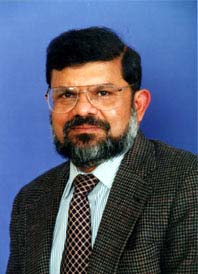

An Ohio State University engineer and his colleagues have discovered something new about a 50-year-old type of fiberglass: it may be more than one and a half times stronger than previously thought.
That conclusion, and the techniques engineers used to reach it, could help expand applications for glass fibers.
Though the glass fiber industry is currently suffering the same economic woes as many other businesses, the time is right to lay the groundwork for future applications, said Prabhat K. Gupta, professor of materials science and engineering.
The half-century-old glass, called E-glass, is the most popular type of fiberglass, and is often used to reinforce plastic and other materials. In a February issue of the Journal of Non-Crystalline Solids, Gupta and his co-authors describe an improved method for measuring the strength of E-glass and other glass fibers, including those used in fiber-optic communications.
The method would be relatively easy to implement in industry, and involves holding a glass fiber at low temperatures and bending it until it breaks. The key, Gupta said, is assuring that a sample is completely free of flaws before the test.
Gupta isn’t surprised that nobody definitively measured the strength of fiberglass before now. “Industries develop materials quickly for specific applications,” he said. “Later, there is time for basic research to further improve a material.”
E-glass was created in the 1950s to insulate electronics. Today, it’s used to strengthen plastics for everything from bathtubs to car door panels. Other types of fiberglass are used to make heat-resistant cloth, rope, and home insulation.
To improve a particular formulation of glass and devise new applications for it, researchers need to know how strong it is under ideal conditions. So Gupta and his colleagues — Charles Kurkjian, formerly of AT&T Bell Labs and now a visiting professor of ceramic and materials engineering at Rutgers University; Richard Brow, professor and chair of ceramic engineering at University of Missouri-Rolla; and Nathan Lower, masters student at University of Missouri-Rolla — had to determine the ideal conditions for the material.
In their latest work, the engineers outlined a set of procedures that researchers in industry and academia can follow to assure that they are measuring the ideal strength of a glass fiber.
For instance, if small-diameter versions of the fiber seem stronger than larger diameter versions, then the glass most likely contains flaws. That’s because the ideal strength depends on inherent qualities of the glass, not the diameter of the fiber, Gupta said.
To measure the ideal strength of E-glass, he and his coauthors experimented on fibers that were 100 micrometers thick — about the same thickness as a human hair — held at minus 320F (minus 195C). They bent single fibers into a “U” shape and pressed them between two metal plates until the fibers snapped at the fold.
The fibers withstood a pressure of almost 1.5 million pounds per square inch — roughly 1.7 times higher than previous recorded measurements of 870,000 pounds per square inch. The results suggest that the engineers were able to measure the material’s true strength.
Knowing more about the strength of fibers can help manufacturers improve production. The process is the same now as when Gupta was a senior scientist at Owens-Corning Fiberglas Corp. in Granville, Ohio, in the 1980s: glass melts in a giant crucible with thousands of holes in the bottom. When the molten glass flows down through the holes, it is stretched to form long fibers, a procedure Gupta likens to “pulling strings from honey.”
If even a single strand of glass breaks, it can whip around and shatter the other fibers, he said. Production grinds to a halt while workers clean up the mess and start over.
Strength is an issue for optical fiber as much as E-glass and other reinforcement fibers. “Even if you’re interested in a glass for its optical properties, you still have to be able to handle the glass and know how long it will last,” Gupta said.
Given the telecommunications industry’s current slump, however, Gupta doubts that optical fiber makers will be looking to dramatically improve the strength of their product.
“Even very high quality optical fiber is dirt cheap today,” he said. “A more likely application is in the auto industry, where reinforced plastics could replace metal parts and make cars lighter and more fuel efficient.”
Gupta and his colleagues next hope to study the atomic level structure of glass and learn more about what contributes to strength at that level.
Contact: Prabhat Gupta, (614) 292-6769; Gupta.3@osu.edu
Written by Pam Frost Gorder, (614) 292-9475; Gorder.1@osu.edu












